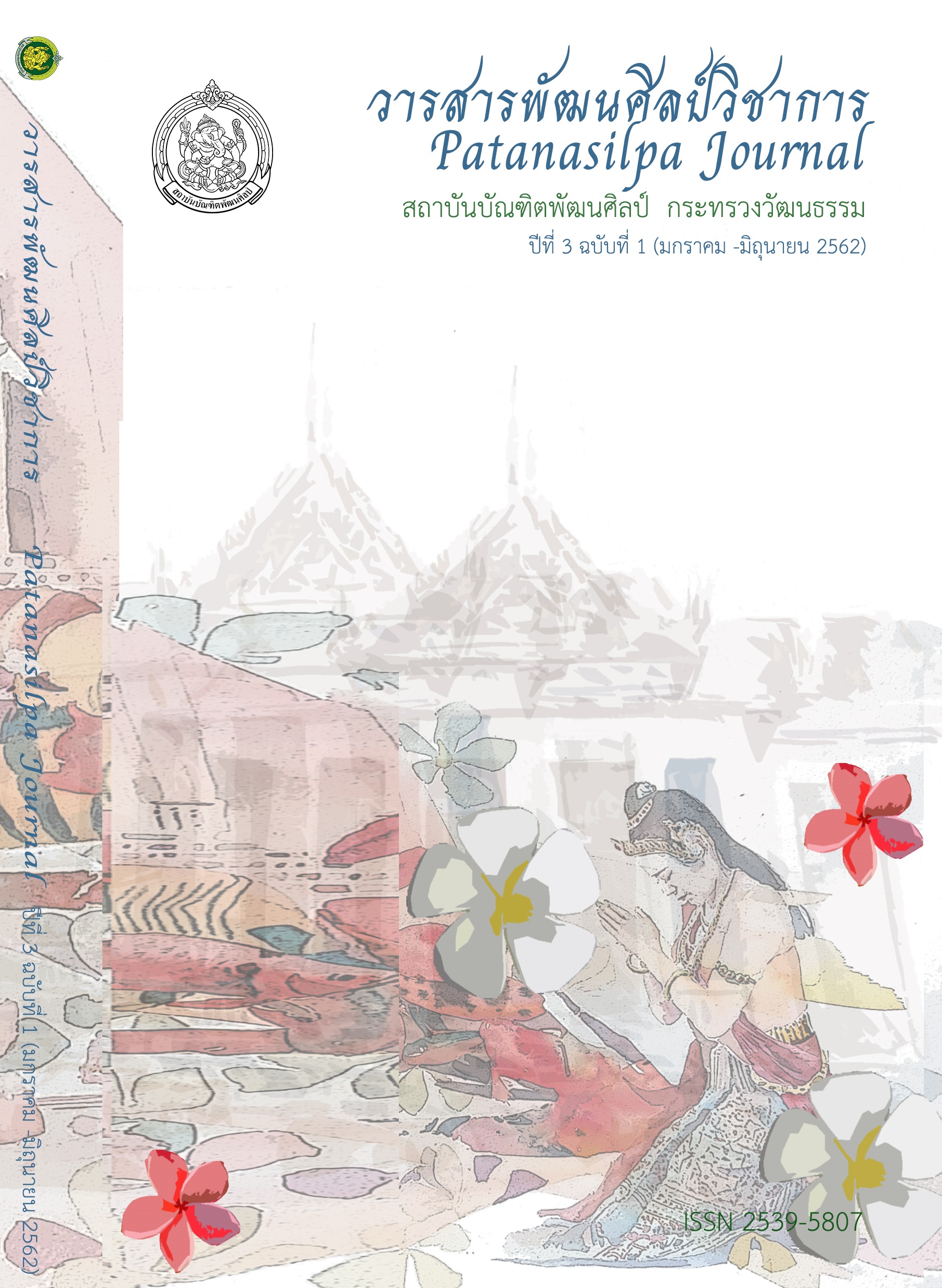อัตลักษณ์ของสตรีในวรรณกรรมไทยร่วมสมัย พ.ศ. 2550-2560: สถานภาพและบทบาทของสตรีทางด้านเศรษฐกิจ การเมือง สังคม และวัฒนธรรม
คำสำคัญ:
อัตลักษณ์ของสตรีในวรรณกรรมไทยร่วมสมัย, สถานภาพ, บทบาทบทคัดย่อ
การวิจัยครั้งนี้มีวัตถุประสงค์เพื่อศึกษาอัตลักษณ์ของนางเอกหรือตัวเอกหญิงในนวนิยาย พ.ศ. 2550-2560 จากสถานภาพการเป็นภรรยาหรือคู่รักที่มีบทบาททางด้านเศรษฐกิจ การเมือง สังคมและวัฒนธรรมในการครองเรือนหรือการครองรัก โดยใช้ระเบียบวิธีวิจัยเชิงคุณภาพ ด้วยการวิเคราะห์เนื้อหานวนิยายเฉพาะบทบาทของนางเอกหรือตัวเอกหญิง
ผลการศึกษาพบว่า เศรษฐกิจในการครองเรือนหรือการครองรักของนางเอกหรือตัวเอกหญิงที่พึ่งพาสามีด้วยการเป็นแม่บ้านที่สามียกย่องไว้ใจจะมีอัตลักษณ์เป็นตัวของตัวเอง มีความมั่นใจในคุณค่าของตนเองและมีความมั่นคงทางอารมณ์ ถ้าเป็นแม่บ้านที่สามีคอยควบคุมหรือออกคำสั่งให้ปฏิบัติตามจะมีอัตลักษณ์ที่ให้ความเคารพตนเองต่ำ ไม่เห็นคุณค่าของตนเอง เก็บกด หากพึ่งพาตนเองทั้งการทำงานในองค์กร และสร้างอาชีพของตนเองจะมีลักษณะเป็นคนแน่วแน่ เข้มแข็ง กล้าหาญ มั่นใจในตนเอง รักความเป็นอิสระ เด็ดเดี่ยว มีความมุ่งมั่นไม่ยอมแพ้ สำหรับการเมืองในการครองเรือนหรือการครองรักด้วยความเสมอภาคทางเพศ นางเอกหรือตัวเอกหญิงจะมีอัตลักษณ์เป็นคนตรงไปตรงมา มีความชัดเจน โปร่งใส เปิดเผย หากมีความเหลื่อมล้ำทางเพศจะมีอัตลักษณ์เป็นคนเก็บกด มีความขัดแย้งในตนเอง ไม่มั่นใจและไม่เป็นตัวของตัวเอง ส่วนสังคมและวัฒนธรรมในการครองเรือนหรือการครองรักของนางเอกหรือตัวเอกหญิงที่มีธรรมของผู้ครองเรือนจะมีอัตลักษณ์เป็นคนแน่วแน่ หนักแน่น มีความมั่นคงทางอารมณ์ มุ่งมั่น เด็ดเดี่ยว ถ้าไม่มีธรรมของผู้ครองเรือนจะมีอัตลักษณ์เป็นคนใจคอคับแคบ ไม่มั่นคงทางอารมณ์
เอกสารอ้างอิง
กฤษณา อโศกสิน. (2560). กระจกขอบทอง. กรุงเทพฯ: อักษรโสภณ.
งามพิศ สัตย์สงวน. (2553). สังคมและวัฒนธรรม. กรุงเทพฯ: บริษัทด่านสุทธาการพิมพ์ จำกัด.
จุฑาพรรธ์ (จามจุรี) ผดุงชีวิต. (2550). วัฒนธรรมการสื่อสารและอัตลักษณ์. กรุงเทพฯ: จุฬาลงกรณ์มหาวิทยาลัย.
ตรีศิลป์ บุญขจร. (2560). นวนิยายกับสังคมไทย (2475-2500). กรุงเทพฯ: โครงการเผยแพร่ผลงานวิชาการ คณะอักษรศาสตร์จุฬาลงกรณ์มหาวิทยาลัย.
ทัศนีย์ ทองสว่าง. (2549). สังคมวิทยา. กรุงเทพฯ: โอเดียนสโตร์.
ธเนศ วงศ์ยานนาวา. (2559). เพศ. กรุงเทพฯ: สมมติ.
ธัญญา สังขพันธานนท์. (2559). แว่นวรรณคดี ทฤษฎีร่วมสมัย. ปทุมธานี : นาคร.
พระใกล้รุ่ง ปญฺญาวชิโร. (2559). "หลักฆราวาสธรรมกับการปฏิบัติตนสู่ความดีงาม". วารสารมหาวิทยาลัยมหามกุฏราชวิทยยาลัย วิทยาเขตร้อยเอ็ด, 5, 2: 263-271.
รื่นฤทัย สัจจพันธุ์. (2557). “วรรณกรรมในสมัยรัชกาลที่ 7: การตอบสนองรสนิยมของชนชั้นกลาง”. วารสารมนุษยศาสตร์และสังคมศาสตร์ มหาวิทยาลัยราชภัฏสุราษฎร์ธานี, 6, 1: 77-100.
วนิดา บำรุงไทย. (2544). ศาสตร์และศิลป์แห่งนวนิยาย. กรุงเทพฯ: ชมรมเด็ก.
ว. วินิจฉัยกุล. (2550). มาลัยสามชาย. กรุงเทพฯ: ศรีสารา.
________. (2560). ความฝันครั้งที่สอง. กรุงเทพฯ: อรุณ.
สุพัตรา สุภาพ. (2536). ค่านิยม ครอบครัว ศาสนา ประเพณี (พิมพ์ครั้งที่ 8). กรุงเทพฯ: ไทยวัฒนาพานิช.
สุรเชษ์ฐ สุขลาภกิจ. (2561). ผัวเดียวเมียเดียว อาณานิคมครอบครัวในสยาม. กรุงเทพฯ: มติชน.
อุรุดา โควินท์. (2560). หยดน้ำหวานในหยาดน้ำตา. กรุงเทพฯ: มติชน.
ดาวน์โหลด
เผยแพร่แล้ว
ฉบับ
ประเภทบทความ
สัญญาอนุญาต
บทความที่ได้รับการตีพิมพ์เป็นลิขสิทธิ์ของ สบศ.






